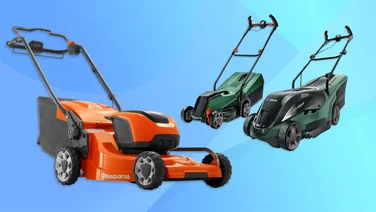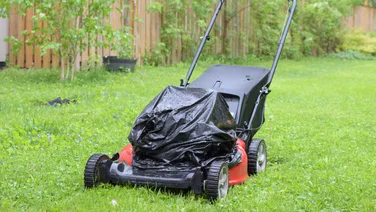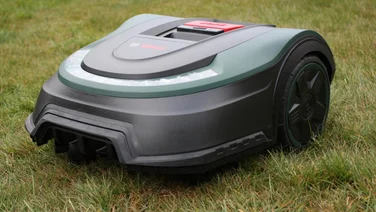To help us provide you with free impartial advice, we may earn a commission if you buy through links on our site. Learn more














- Covers large areas
- Decent cutter
- Doesn’t require a boundary wire
- Very expensive
- Relies on a clear view of the sky
- Some setup niggles
EcoFlow is best known for its portable power supplies, so the EcoFlow Blade is an unusual side-step into robot lawn mowing. To the company’s credit, however, it has truly embraced the challenge, coming up with a product that throws the traditional robot mower playbook under the rotor blades.
Looking more like a Martian rover than a robot lawn mower, the Blade brings a different design aesthetic. Out goes the garish cover-all plastic casing, in comes a minimalist brushed metal frame, unusual angles and a bare-bones chic that’s intended to turn heads.
It’s not just about the looks, though, with a number of other innovations that might leave you wondering why you’re putting up with your existing model. This includes such wonders as wire-free GPS-driven navigation, a logical cutting pattern and an optional lawn sweeper – something we haven’t seen in any of our other tried-and-tested robot lawn mowers.
EcoFlow Blade review: What do you get for the money?
Before we explore what comes in the elegantly-presented box of the EcoFlow Blade, let’s just have a quick word about the price. This is a phenomenally expensive robot lawn mower, costing £2,699 on Amazon at the time of writing. That doesn’t include the lawn sweeper, which costs an additional £699, though you can buy both at the same time and save £200.
Justification for this high price is problematic, to say the least. It’s probably the most significant barrier this robot mower has to a hearty recommendation. However, there are a few things to consider that might help you justify its price.














The main thing is what’s missing from the box – a perimeter wire. Most robot lawn mowers require you to lay a boundary around the area that you want to mow. By connecting both ends of this wire to the charging station, it creates a low-powered electrical circuit that the robot will not cross, protecting your flower beds and vegetable patch from a rogue mower.
Instead of a wire, the EcoFlow Blade uses an undisclosed global navigation satellite system (GNSS) to navigate its way around your garden. Before you let it loose, you have to guide it around the edge of your lawn using a virtual remote control in the device’s app. The mower then uses this as the boundary it will never cross.
EcoFlow claims that this system leaves it capable of looking after a lawn of up to 3,000m2, or the equivalent of 0.75 acres. This won’t just mow your garden, it’ll have a good stab at the meadow beyond if you’re in the fortunate position of having one.
This wide-ranging coverage is the other main benefit as far as price is concerned. Worx’s new Landroid Vision L1600 WR216E, for example, costs £2,400 but covers a maximum of 1,600m2. The Husqvarna Automower 415X also uses satellites and costs £2,299, but can only cover 1,500m2. If you have the land, the EcoFlow Blade offers a lot more mowing for a bit more money.














The satellite navigation explains the item in the box that most lawn mowers don’t have – a 1.4m antenna that wires up to the base station. During setup, this needs constructing and placing in an area with a clear view of the sky that’s outside the mowing area. It picks up the satellite information and triangulates the position of the mower, which can then mow close to trees and buildings without getting lost.
The mower itself has a very unusual design. Measuring 440 x 640 x 310mm (WDH), it’s made from a remarkably heavy metal frame (weighing 16kg in total) with few external controls. The essential big red stop button is present, with a bank of buttons below that to power the mower on and off, start a mow, or send it back to charge. There’s a rain sensor on the top to keep the mower on its base when your lawn might be slippy.
It has two large rear wheels that are used for traction and steering, as with most robots. At the front are two wheels that are set at a 45-degree angle, as if it’s trying to steer in both directions at once. These aren’t ordinary wheels, though. The tyres are actually a series of individual 3cm wheels, mounted perpendicularly to the main wheel. These roll around in the opposite direction to how you think wheels should work and I can’t quite get my head around what’s going on, but they’re designed to stop the robot getting stuck and, in my tests, did a good job of it.














On the underside of the mower, the EcoFlow Blade uses the same cutting system as every other robot lawn mower we’ve reviewed to date – a spinning disc with three razor-like blades attached. The width of this apparatus is 26cm, which is on the large side, so should help the mower cover more ground on each pass. However, you don’t need to get too hung up on this specification because the Blade gains far more from its precision lawn coverage than it does from the size of its cutting plate.
At the front, the mower uses LIDAR to detect significant obstacles in its path. It successfully navigated around the whirlygig I have on my lawn and a garden chair that I left out to try and trip it up. These large obstacles were avoided well, but smaller obstacles proved a problem. I left out a stick my dog had been chewing and a ball a bit larger than a tennis ball. Both of these were ignored, with the robot grounding itself on the stick.
The charging base that the mower rolls back onto when it’s finished is a solid plastic plate measuring 715 x 501 x 205mm (WDH). It also comes with around 8m of cable to connect to a power supply and a second length of cable for connecting the antenna to the base station.
READ NEXT: The best lawn mowers to buy for small gardens
EcoFlow Blade review: Is it difficult to set up?
The whole point of a wire-free installation is that it should be easier to set up. The EcoFlow Blade is certainly easier to set up than any wired system we’ve reviewed, but it’s not a drop-and-mow device along the lines of the LawnMaster VBRM16.
That’s because there are a few things you still need to do. For starters, it uses a standard-looking charging station, with a flat base for the Blade to park on and a tower rising up that it butts into for charging. As usual, the base needs pinning to the ground and connecting to an outdoor power socket.














The GNSS antenna also needs to be built and positioned. If you put this well away from tall trees and buildings it shouldn’t cause you any problems and the app will tell you if it’s not in a good position. I didn’t encounter any issues in my garden but I have a clear view of the sky from where I chose to locate the antenna.
It’s the final piece of the puzzle that’s actually the most fiddly. When the robot is sufficiently charged, you have to walk it around the perimeter of the area you want it to cut with the rudimentary app-based remote control. This uses a virtual joystick that you slide around the screen, though I found it cumbersome at best. I couldn’t walk it around the perimeter of my lawn in a singular smooth operation and ended up resorting to short bursts of forward motion, realigning the heading after each spurt. Although it’s fiddly, for most people this will still be a clear winner over getting onto your hands and knees to lay and peg down a wire.














You can set up to two mowing areas and connect them with a path along which the robot doesn’t mow. This means you could potentially mow both front and back lawns, even if they’re connected by a path.
The last thing to do is to set it mowing. Configuring the mower with the app is simple, with shortcuts on the main mowing screen that take you to scheduling, speed and grass height.
EcoFlow Blade review: How well does it mow the lawn?
For the money, you’d hope that the EcoFlow Blade would make a good job of cutting your lawn and it genuinely does. The first thing to note is that because it creates such an accurate lawn map, it can fill the space inside the perimeter accurately, too. There’s no requirement for random mowing here, the Blade simply traverses up and down your lawn, turning at the end and moving along slightly to mow the next strip. It’s probably exactly how you’d mow the lawn manually, but even more precise.
Its regular mowing pattern is mostly a good thing. Most robot mowers still mow randomly, which means they have to be active for longer stretches of time to cover every inch of your lawn. The system used by the Blade is fast and efficient, and it doesn’t have to keep going over the same ground.














One downside is that it always appears to cut the lawn in the same direction. It would have been nice to have the lawn mowed alternately at a 90-degree angle on occasion, but that wasn’t an option I could find in the settings.
Another thing it doesn’t do automatically is perform an edge routine to ensure all the borders are straight. I was going to write this off as a missed opportunity, but then found the option switched off, deep in the app settings. It’s worth exploring every nook and cranny of these settings, as there are useful things here, such as changing the mowing height from inches to millimetres.
Speaking of which, the Blade has the broadest range of cutting height options I’ve seen on a robot mower, ranging from 20mm to 70mm. The cutting height is controlled from the app, so you can change it part way through a mow, and the slider moves in 1mm increments, which is extremely fine control that I haven’t seen elsewhere – 5 or 10mm increments are far more common.














Robot lawn mowers typically leave a strip of unmowed space around the edge of the lawn – even cut-to-edge mowers such as the Worx Landroid M500 Plus WR165E – and the Blade is no different. However, because I had slightly more control over the perimeter than you get with the relatively abstract practice of laying down a wire that a mower will follow through its centre, it’s easier to take the mower right up to the edge. This reduces the amount of additional strimming or mowing you’re going to need to do.
While the mower doesn’t come with a roller, the combination of its wheels, its cutting blades and the regularity of the movement meant that it left stripes in my lawn as it mowed. These are relatively thin, only about 15cm wide, so aren’t like the broad stripes you’d get from a large manual mower with a roller attached. However, it’s a satisfying look that you rarely get from a robot.
I found the mowing to be exceptional. It neatly handled undulations and my lawn was maintained uniformly short while I had the device in use. With the manual edge setting, I found it got closer to the edge than any wired mower I’ve ever used, leaving me with less additional work to do strimming or manually mowing around the edges.














I was also sent the £699 Sweeper Kit for review. It consists of an attachment that connects to the back of the mower, screwing onto the lifting handle. There’s also a cable that connects to a hidden port. This powers a rotating rubber brush that sits inside the attachment, and flicks lawn debris into a fairly standard-looking collection bin that hooks onto the rear.
The documentation suggests you use the sweeper to collect leaves from the lawn. I tested the device in early summer when leaves were in short supply, so I tore up some scrap paper into leaf-sized pieces and scattered those over my lawn instead. The device picked them up perfectly, missing only a couple of ‘leaves’ but collecting many, many more. It also ended up filling itself with a lot of loose grass clippings, which was a pleasant surprise as manufacturers don’t tend to flag this benefit.
I can’t honestly suggest that the Sweeper Kit is worth £699 because that’s an extraordinary amount of money. However, if you have a large garden that’s prone to being covered with leaves in the autumn, this is surprisingly effective and will undoubtedly save you from a lot of raking.
EcoFlow Blade review: Should you buy it?
There’s a lot to like about the EcoFlow Blade, but some of it is superficial. It looks fantastic, with a truly eye-catching design that’s guaranteed to spark a conversation between you and your neighbours. It doesn’t need a boundary wire, which is a significant benefit over many mowers, as long as you have a clear view of the sky.
It did a very good job of mowing my lawn, and it did it quickly and efficiently. Compared to a random mower that may need to be left out for hours to ensure it covers a whole lawn, the accurate and measured approach of the EcoFlow Blade impressed me greatly.
It’s also extremely expensive, significantly pricier than the vast majority of robot mowers, but not those that are capable of covering the same distance and that use satellite navigation rather than a wire. The Sweeping Kit adds another chunk to the price but could save a lot of labour in a large garden.
Clearly, this is not a budget mower for a small garden, but those with a large space and the money to spend could save a great deal of time and effort, both through the summer and the autumn, by going all-in on the Blade and its sweeper.
If you’ve got a slightly smaller garden up to around 700m2 in size, then you can still get regular mowing patterns and stripes from some wired lawn mowers for a cheaper price. Bosch’s Indego range goes up to 700m2, though we reviewed the Indego S+ 500 which can manage up to 500m2. For smaller spaces, that could be enough considering it’s less than half the price.
Alternatively, for a much more affordable wire-free mow, consider the LawnMaster VBRM16. It’s worth noting, however, that this mows in a random pattern and can only cope with gardens up to 100m2 in size. It also uses cameras to detect grass, rather than satellite navigation, so is fooled by lawns that aren’t pristine.








